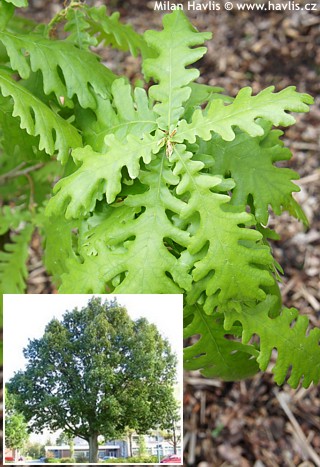Quercus frainetto

Quercus frainetto
Hungarian oak (Italian oak)
Hungarian oak (Italian oak)
| SIZE/TYPE | tall tree |
|---|---|
| USUAL HEIGHT | 8-25m |
| USUAL WIDTH | 3-15m |
| LEAVES | deciduous broadleaf |
| COLOUR OF LEAVES |
 green green |
| FLOWERS | insignificant or non-blooming |
| LOCATION | full sun |
| USDA zone (lowest) | 5b (down to -27°C) |
| WINTER PROTECTION | |
| FOR ZONE 5+6 |

|
| FOR ZONE 7 |

|
| BELONGS TO CATEGORIES | Deciduous broadleaf |
Oaks are common trees of our natural woodlands. They border our ponds, occur naturally in our mixed forests, and make magnificent specimen trees in our parks and arboretums where less common species or rare varieties can be seen. Italian or Hungarian oak originated in warmer parts of Europe from Balkan to Hungary. It was first introduced and cultivated as an ornamental tree from early 19th century.
Hungarian oak is a very handsome tree with attractive foliage. Its leaves are distinctly margined with small, rounded lobes. They are deciduous, up to 20 cm long and glossy, bright green when they emerge, turning darker green in summer, leaving a showy texture of light green veins. Autumn colour is yellow and brown. They are the key feature because of which this tree is grown even in smaller gardens though mature trees can reach about 20 m tall and 7-8m wide in maturity (50 years and more).
It grows slowly or moderately, well established trees can make 20-30 cm per year. Trees develop a rounded crown in about 10 years, spreading to sides with age. It is often cultivated as a shrub where you can fully enjoy its leaves from the ground and you can control its size by regular pruning. You can prune it at the end of winter to virtually any shape required. When cut back (cutting off about two thirds of last years’ growth) in February or March it makes long new branches with plenty of large leaves.
This oak will grow in most soil conditions but prefers neutral to slightly acid soil. Avoid wet sites but constant moisture will ensure healthy, lustrous foliage and regular growth. Grow it in full sun or light shade for only a part of the day. The roots are not dangerous for roads and pavements which makes it suitable for city planting. Newly planted trees need to be staked for 2-3 years to establish. Fully hardy to min. -27°C (USDA zone 5b), perhaps a little more.
Last update 05-02-2010; 07-11-2016
Hungarian oak is a very handsome tree with attractive foliage. Its leaves are distinctly margined with small, rounded lobes. They are deciduous, up to 20 cm long and glossy, bright green when they emerge, turning darker green in summer, leaving a showy texture of light green veins. Autumn colour is yellow and brown. They are the key feature because of which this tree is grown even in smaller gardens though mature trees can reach about 20 m tall and 7-8m wide in maturity (50 years and more).
It grows slowly or moderately, well established trees can make 20-30 cm per year. Trees develop a rounded crown in about 10 years, spreading to sides with age. It is often cultivated as a shrub where you can fully enjoy its leaves from the ground and you can control its size by regular pruning. You can prune it at the end of winter to virtually any shape required. When cut back (cutting off about two thirds of last years’ growth) in February or March it makes long new branches with plenty of large leaves.
This oak will grow in most soil conditions but prefers neutral to slightly acid soil. Avoid wet sites but constant moisture will ensure healthy, lustrous foliage and regular growth. Grow it in full sun or light shade for only a part of the day. The roots are not dangerous for roads and pavements which makes it suitable for city planting. Newly planted trees need to be staked for 2-3 years to establish. Fully hardy to min. -27°C (USDA zone 5b), perhaps a little more.
Last update 05-02-2010; 07-11-2016
SIZES and PRICES
CURRENTLY SOLD OUT
GLOSSARY
|












